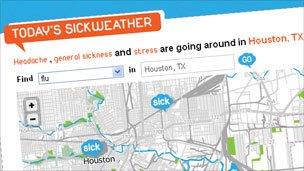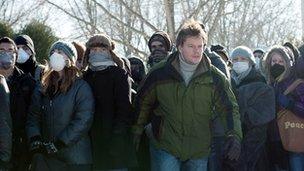Can crowdsourcing beat the flu?
- Published
- comments

Millions of people around the world are bracing themselves for their annual battle with flu. Could new crowdsourcing software be the answer to their prayers?
There doesn't seem to be any way out of it.
As the person next to you on the bus sneezes and you visualise tiny droplets of the virus spiralling towards you, you just know that, sooner or later, it will get you.
It seems unlikely that a smartphone application, as opposed to more tried-and-tested methods like vaccination or a face mask, could help you avoid going down with a dose of the flu this winter.
But that is what the creators of the website Sickweather, external, which launched this week in the US, claim.
Health professionals around the world already use online tools, such as Google Flu Trends, external, Health Map, external or Global Public Health Intelligence Network, external to track the spread of infectious diseases.
Researchers at the London School of Hygiene and Tropical Medicine have also launched The Flu Survey, external, which has recruited volunteers from 10 European countries to report symptoms and provide weekly updates of the spread of flu across the continent.
Sickweather claims to be different because it operates in real time using data from social networks, rather than news reports or internet search terms, and is designed for use by individuals, rather than public health officials. It has already been dubbed "Facebook for hypochondriacs".
People who sign up are able to look at a map of the US or the UK and see areas where others have self-reported "symptoms" marked in orange. Soon after the website launched, much of the east coast of the US appeared to be a swathe of orange, although you can burrow down to street level to see who is sick in your neighbourhood.

Co-founder Graham Dodge says it is early days and the site will become more useful as more people sign up to it - but he insists it is not just about allowing people to avoid catching illnesses.
"For people trying to avoid sickness, whether they have compromised immune systems, or simply have a timely engagement that they want to stay healthy for, Sickweather can be used to see where illness is being reported all the way down to the street level, so that the user can be prepared or avoid if they choose.
"Other users may simply want validation and confirmation that they aren't alone with the symptoms they are experiencing."
Another smartphone application, Influ, external, launched earlier this year in the US, asks users to rate the strength of their symptoms on a red dial, before plotting their position on the map so that other app users can avoid them. It has yet to really take off.
Sickweather's chief operating officer and co-founder James Sajor says their site is different because it has developed "robust" algorithms to scan Twitter and Facebook for relevant data to add to that generated by members of its own community.
The company - which is hoping to attract advertising dollars from pharmaceutical companies - is currently talking to health officials in other countries with a view to going global.
On his Twitter feed, external, Mr Dodge encourages fans of Stephen Soderbergh's latest film Contagion, one of a string of recent Hollywood pictures about deadly pandemics, to sign up to the site.
But Columbia University Professor Ian Lipkin, of the Mailman School of Public Health's Centre for Infection and Immunity, a scientific adviser on Contagion, is not convinced that crowdsourcing is an effective way to combat the spread of contagious diseases.
"I don't think this particular vehicle is going to be helpful," he tells BBC News.
Tales of runny noses and fever on Twitter do not offer a reliable way to track disease, he argues, as there is no way of testing their accuracy.
It is not, in any case, that hard to protect yourself from infection, he adds, particularly in the United States, where an estimated 35% of adults get vaccinated for flu every year.
In the UK, only people aged over 65 or in at-risk categories are advised to get a flu jab, with take-up in the elderly category averaging between 72% and 75%.
Professor Lipkin is one of the leading advocates of a global early warning system for contagious disease to reduce the risk of the sort of pandemic seen in Contagion.

Contagion is the latest Hollywood film about a deadly global pandemic
"Right now we are in the early days. We are excited about it and we think it's going to be very important," he tells BBC News.
He believes the system should rely on a range of official sources, such as hospital admissions, prescriptions for anti-viral drug Tamiflu and sales of over-the-counter medicines, rather than anecdotal evidence culled from social media.
But has he been too quick to write off the potential of Twitter as a way of tracking the spread of viruses?
Researchers at the University of Iowa, studying the 2009 swine flu pandemic, compared fluctuations in the use of certain phrases on Twitter with flu cases reported through the US Centre for Disease Control, which has its own sophisticated flu surveillance system.
They were able to spot signs of flu in a geographical area one to two weeks faster than the CDC, which relies on reports of hospital admissions, mortality rates and other official data.
Researchers in Brazil, external have also used Twitter to track the spread of dengue fever, which they hope could speed up the response of the medical authorities to the disease.
The problem is that not everyone uses social media - it tends to be concentrated in major cities - and there is no guarantee people laid up in bed with a high fever will feel like broadcasting their symptoms to the world unless they are caught up in a media panic like the one around the H1N1 virus.
"What is the incentive for people to report? One does wonder why people do this," says one of the authors of the Iowa University Report, external, computer science professor Alberto Maria Segre.
But, he adds, these obvious drawbacks could be outweighed by one major advantage: "What's so cool about this is that we can do it in real time."
And, he stresses, the volume of often useless data generated by social media users during outbreaks of contagious diseases should not be viewed as a problem.
"The information is there. The real trick is how do you check it, how do you make it reliable. How do you make sure somebody is not playing with you for their own benefit? But the potential is there."